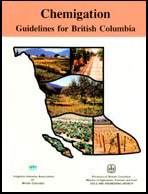Chemigation Guidelines for British Columbia
 Chemigation is the term used to define the practice of applying chemicals to a crop through an irrigation system. In agriculture, the type of chemicals applied are generally fertilizers to promote crop production and plant grownth.
Chemigation is the term used to define the practice of applying chemicals to a crop through an irrigation system. In agriculture, the type of chemicals applied are generally fertilizers to promote crop production and plant grownth.
Commodities such as tree fruits, vegetables, small fruits and berries, greenhouse and nursery operations use trickle irrigation systems to apply fertilizers directly to the plant roots.
In drier climates such as the Okanagan area of British Columbia, the utilization of fertigation techniques is the only viable method of applying ferlizers to crops using trickle irrigation systems.
The intent of the Chemigation Guidelines for British Columbia is to inform the agriculture industry and water purveyors of the laws, regulations and standards that currently exist in British Columbia.
The Guide also provides information of the design and operations of chemigation systems. Guidance on the selection of chemicals and methods of calculating chemical injection rates are also given.
Chemigation Guidelines for British Columbia was prepared by the BC Ministry of Agriculture. It was published in partnership with the Irrigation Industry Association of BC.
Table of Contents :
- Introduction
- Laws and Regulations Affecting Chemigation
- Chemigation Considerations (Advantages/Disadvantages)
- Cross Connection Control
- Chemical Selection
- Injection Equipment
- Calculating Injection Rates
This Guide can be downloaded to your printer free of charge or the bound published book can be ordered from the Irrigation Industry Association of BC for a fee..

